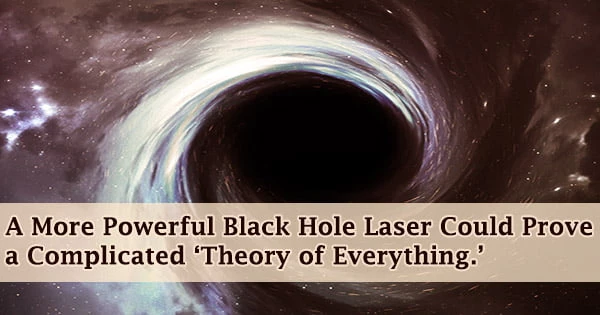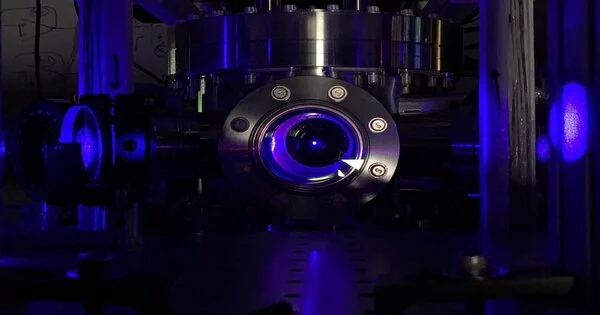The fundamental forces of physics regulate the matter that makes up the Universe, but how these forces interact is still a mystery. The occurrence of Hawking radiation, which is particle emission from black holes in close proximity, shows that general relativity and quantum physics must work together.
However, because to the background noise of the Universe, directly detecting Hawking radiation from a black hole is practically impossible, so how can researchers analyze it to better understand how the forces interact and how they fit into a “Theory of Everything?”
A theory of everything (TOE) is a hypothetical framework for understanding all of the universe’s known physical events. Since the invention of quantum physics and Albert Einstein’s theory of relativity in the early twentieth century, researchers have been looking for a model like this.
Stephen Hawking proposed the innovative theory that a black hole might generate electromagnetic radiation, known as Hawking radiation, through a mechanism that combines gravity, quantum physics, and thermodynamics in 1974. However, it was evident from the start that monitoring this process in nature would be impossible due to the little amount of radiation emitted by a typical black hole.
Jeff Steinhauer has now observed this phenomena in an acoustic counterpart of a black hole, where the Hawking radiation is substantially stronger, as he describes in Nature Physics. From table-top laboratory experiments, this system offers interesting opportunities to learn more about Hawking radiation and related astrophysical processes.
Because researchers cannot go to Hawking radiation, Haruna Katayama, a PhD student at Hiroshima University’s Graduate School of Advanced Science and Engineering, believes Hawking radiation must be delivered to the researchers.
She has developed a quantum circuit that functions as a black hole laser, resulting in a lab-bench black hole equivalent that outperforms earlier proposals. Scientific Reports published the suggestion on September 27, 2021.
“In this study, we devised a quantum-circuit laser theory using an analogue black hole and a white hole as a resonator,” Katayama said.
A white hole is a theorized spouse of a black hole that emits light and matter in the same proportion as a black hole consumes light and matter. A metamaterial built to allow faster-than-light travel spans the distance between horizons, near which Hawking radiation is emitted, in the proposed electric circuit.
The metamaterial element makes it possible for Hawking radiation to travel back and forth between horizons, and the Josephson effect which describes a continuous flow of current that propagates without voltage plays an important role in amplifying the Hawking radiation through the mode conversion at the horizons, mimicking the behavior between the white and black holes.
Haruna Katayama
“The property of superluminal speed is impossible in a normal medium established in an ordinary circuit,” Katayama said.
“The metamaterial element makes it possible for Hawking radiation to travel back and forth between horizons, and the Josephson effect which describes a continuous flow of current that propagates without voltage plays an important role in amplifying the Hawking radiation through the mode conversion at the horizons, mimicking the behavior between the white and black holes.”
Katayama’s concept adds to prior proposals for optical black hole lasers by using a metamaterial that allows for superluminal speed and utilizing the Josephson phenomenon to magnify Hawking radiation. The resulting quantum circuit causes a soliton, which is a confined, self-reinforcing waveform that retains its speed and shape until the system is collapsed by external factors.
“Unlike previously proposed black hole lasers, our version has a black hole/white hole cavity formed within a single soliton, where Hawking radiation is emitted outside of the soliton so we can evaluate it,” Katayama said.
Entangled particle pairs, one inside and one outside the horizon, produce Hawking radiation. The observable entangled particle, according to Katayama, bears the shadow of its companion particle. As a result, the quantum correlation between the two particles may be calculated analytically without having to observe both particles at the same time.
“The detection of this entanglement is indispensable for the confirmation of Hawking radiation,” Katayama said.
However, due to the usual dispersion of light in the suggested scenario, the lab Hawking radiation varies from actual black hole Hawking radiation, Katayama cautioned. As in a rainbow, light components split in one direction.
The resulting lab-made Hawking radiation would have the same positive frequency as actual black hole Hawking radiation if the components could be regulated so that some could reverse and bounce back. She’s now looking on how to incorporate anomalous dispersion into the equation for a more comparable result.
“In the future, we would like to develop this system for quantum communication between distinct spacetimes using Hawking radiation,” Katayama said, pointing to the system’s scalability and controllability as advantages in developing quantum technology.
The Japan Society for the Promotion of Science supported this research.
















